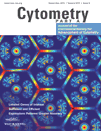|
Conclusion:
|
These data show that Plasmodium vivax triggers the indiscriminate recruitment of innate-like and adaptive T cells to inflamed tissues (most likely the spleen) during infection. All major T cell subsets are recruited proportionally leading to a loss of 35-70% circulating lymphocytes at the peak of infection. After drug treatment (and clearance of parasites) T cells return to circulation at near-normal levels; remarkably, 10-20% of the T cell compartment has an activated (CD38hi Bcl2lo) phenotype at this time-point. On average, more than half of all activated cells are CD4+ and most display an effector memory phenotype. Activated CD4+ T cells are phenotypically heterogeneous, displaying diverse expression profiles of activation, differentiation and proliferation markers. They also demonstrate marked variation in their expression of key checkpoint inhibitors. Overall, these data suggest a potent stimulatory environment during human malaria that leads to the global recruitment and activation of T cells, and the polarisation of CD4+ T cells towards a Th1 fate.
|
|
Comments:
|
Staining and acquisition was performed at the MRC Weatherall Institute for Molecular Medicine in Oxford, UK, in collaboration with Michalina Mazurczyk and Giorgio Napolitani.
CyTOF was used to resolve changes in the peripheral T cell pool through time in six volunteers (named v02, v03, v05, v06, v07, v09). Demographic information of this cohort is shown in a spreadsheet attached to this experiment. Each volunteer was sampled at four timepoints: C-1 (one day before infection), C10, (ten days after infection) DoD (day of diagnosis, immediately before treatment), T+6 (six days post-treatment). The filename contains both the timepoint and individual from whom the sample was taken.
FCS files were generated using CyTOF software (version 6.7, Fluidigm). All further processing and analysis was carried out in R. Bead normalisation (Finck et al., 2013 Cytometry Part A), debarcoding (Zunder et al., 2015 Nature Protocols) and compensation (non-negative least-squares (NNLS) Chevrier et al. 2018, Cell Systems) was done using the CATALYST workflow described in Nowicka et al. (209 F1000 Research).
https://www.bioconductor.org/packages/release/bioc/html/CATALYST.html
FlowSOM metaclustering and manual merging were used to classify T cells into subsets. For differential abundance analysis cluster frequencies were modelled using edgeR GLMs implemented in the diffcyt package,
https://www.bioconductor.org/packages/release/bioc/html/diffcyt.html
This repository contains fcs files that have been pregated on CD45+CD3+CD20- singlet T cells (see the attached gating XML and gating strategy PNG files). Ungated whole blood will shortly be uploaded to a separate experiment. Should this be of interest to you ahead of publication, please get in touch and we will be happy to share.
|

